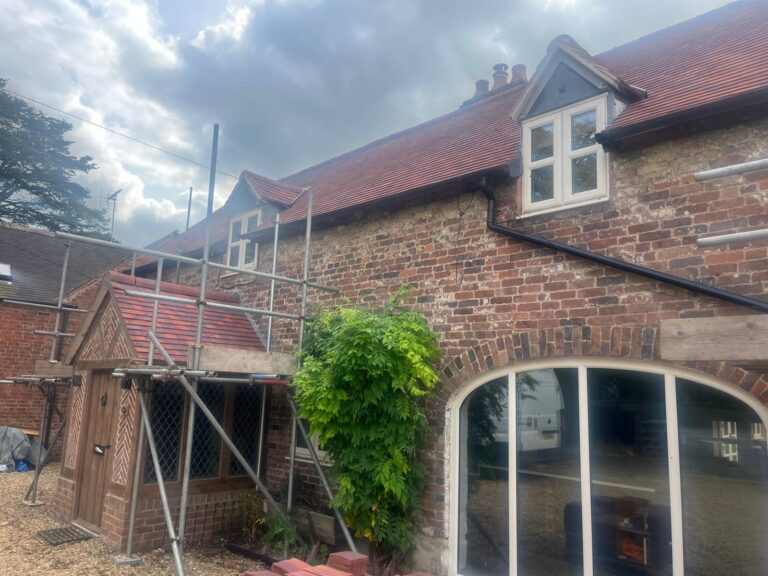
Round roofing are a roofing company that has traded in and around Kidderminster for over 50 years.
When homeowners think about roof maintenance, they often focus on tiles, gutters, or leaks but one of the most vital, yet frequently overlooked aspects of roof health is ventilation. A well-ventilated roof doesn’t just prevent moisture build-up; it protects your entire home’s structure, boosts energy efficiency, and extends the lifespan of your roofing system.
In Kidderminster, where damp weather and changing temperatures are common, poor roof ventilation can quickly lead to mould, rot, and costly damage. At Round Roofing, we’ve seen first-hand how inadequate airflow can silently compromise even the strongest roof over time.
In this in-depth guide, we’ll explore:
What roof ventilation is and how it works.
Why it’s so important for Kidderminster homes.
The warning signs of poor ventilation.
The benefits of getting it right.
How professionals assess and improve your roof’s airflow.
By the end, you’ll understand why roof ventilation isn’t just a small detail, it’s a critical part of your roof’s long-term performance.
1. What Is Roof Ventilation?
Roof ventilation is the process of allowing air to circulate freely through your roof space or loft. This is typically achieved using vents, ridge gaps, soffit panels, or mechanical systems that let warm, moist air escape while drawing in cooler, drier air.
A properly designed ventilation system maintains a steady flow of air through your roof cavity, helping regulate temperature and humidity levels all year round.
There are two main types of roof ventilation systems:
1.1 Natural Ventilation.
This relies on air pressure and temperature differences to drive airflow. Cooler air enters through low-level vents (usually soffits) and exits through high-level vents (such as ridges or gables).
1.2 Mechanical Ventilation.
Used when natural airflow isn’t enough, these systems use fans or powered vents to actively move air through the roof space.
Both systems share one goal, to maintain a balanced exchange of air so that the roof remains dry, cool, and protected.
2. Why Roof Ventilation Matters for Kidderminster Homes.
Kidderminster’s climate is famously unpredictable. The combination of frequent rain, mild summers, and cool, damp winters creates ideal conditions for condensation and mould growth if a roof isn’t properly ventilated.
Here’s why it matters so much in our region:
2.1 Prevents Condensation and Damp.
Warm air from your home naturally rises into the loft. When that moist air meets the cold surfaces of your roof during winter, it condenses into water droplets. Over time, this can cause:
Mould and mildew growth
Damp insulation
Rotting rafters and joists
Damage to plaster ceilings
Proper ventilation keeps air moving, preventing moisture from settling and keeping the space dry.
2.2 Protects Insulation Performance.
When insulation becomes damp, it loses its ability to trap heat effectively. In Kidderminster homes, where energy efficiency is crucial, poor ventilation can make your heating bills soar.
A well-ventilated roof ensures insulation stays dry and performs at peak efficiency.
2.3 Extends Roof Lifespan.
Trapped heat and moisture accelerate the deterioration of roofing materials, especially timber structures and felt underlays. Ventilation reduces temperature fluctuations and moisture build-up, helping your roof last decades longer.
2.4 Prevents Ice Dams and Winter Damage.
During cold spells, heat trapped in an unventilated loft can cause snow to melt unevenly, refreezing at the eaves and creating ice dams. These can lift tiles and cause leaks, a problem easily avoided with proper ventilation.
2.5 Keeps Your Home Cooler in Summer.
Good ventilation doesn’t just protect against moisture; it also helps reduce attic heat during warmer months. When air can circulate, your roof doesn’t trap heat, keeping your entire home cooler and more comfortable.
3. The Signs of Poor Roof Ventilation.
Many homeowners in Kidderminster don’t realise their roof has ventilation problems until the damage is already done. Look out for these warning signs:
Condensation on windows or in the loft, often visible in the mornings.
A musty smell in the attic or upper floors.
Mould or mildew on rafters, ceilings, or insulation.
Peeling paint or damp patches on ceilings.
Rusting nails or metal components in the roof space.
High energy bills due to poor insulation performance.
Uneven roof temperatures (some areas melting snow faster than others).
If you notice any of these, it’s time to have your roof inspected by a local expert.
4. How Roof Ventilation Works: The Science Behind It.
Proper roof ventilation relies on a simple principle, airflow balance. Warm, humid air rises naturally, while cool air stays lower.
An effective system allows cool air to enter through soffit or eave vents and warm air to exit through higher vents such as ridge vents or roof tiles.
This constant movement:
Keeps humidity under control.
Reduces condensation risk.
Stabilises roof temperature.
It’s a continuous cycle, and when designed correctly, it works automatically with minimal maintenance.
5. Common Ventilation Mistakes We See in Kidderminster.
At Round Roofing, we’ve inspected hundreds of roofs in and around Kidderminster and often find the same ventilation issues:
5.1 Blocked Soffit Vents.
Over time, paint, dust, and insulation can block soffit vents, cutting off airflow. Even small obstructions can dramatically reduce performance.
5.2 Too Few or Poorly Placed Vents.
Many older homes were built with minimal ventilation, which isn’t enough for modern insulation standards. Others have vents in the wrong locations, causing air to circulate unevenly.
5.3 Unvented Flat Roofs.
Flat roofs often suffer from poor ventilation because they lack natural airflow paths. Without specialist systems, moisture becomes trapped, leading to rot or blistering.
5.4 Excessive Ventilation.
Too much ventilation can also be a problem, it can draw in cold air or even rain during storms if incorrectly installed. The key is balance.
6. The Steps to a Professional Roof Ventilation Inspection.
When Round Roofing inspects a property in Kidderminster for ventilation issues, we follow a thorough, step-by-step process:
Step 1: Visual Assessment.
We begin by examining the exterior roof structure, checking for visible vents, gaps, or signs of blocked airflow.
Step 2: Loft Space Evaluation.
Next, we inspect the internal roof space, looking for condensation, mould, or damp insulation. We also check airflow between rafters.
Step 3: Airflow Testing.
We may use smoke tests or airflow meters to measure how effectively air moves through the roof space.
Step 4: Identifying Imbalances.
We assess whether intake and exhaust vents are properly balanced, too much exhaust without enough intake can cause suction and draw in moisture.
Step 5: Recommendations and Solutions.
Finally, we provide a detailed report and propose the best solutions for improving airflow.
7. How to Improve Roof Ventilation.
There are several ways to enhance your roof’s ventilation system, depending on your property’s age, size, and design:
7.1 Add Soffit Vents.
Installing new soffit vents or clearing existing ones allows cool air to enter the roof space.
7.2 Fit Ridge or Tile Vents.
Ridge vents provide consistent air exhaust along the roof’s peak, while vented tiles are ideal for targeted ventilation.
7.3 Install Gable Vents.
Perfect for homes with pitched roofs, gable vents improve cross-flow ventilation.
7.4 Mechanical Roof Fans.
In properties with limited natural airflow, mechanical fans can help maintain a steady air exchange rate.
7.5 Replace Blocked Felt with Breathable Membrane.
Older roofs may have non-breathable felt underlays that trap moisture. Upgrading to a breathable roofing membrane allows moisture vapour to escape naturally.
8. The Benefits of Proper Roof Ventilation.
Investing in roof ventilation offers significant benefits:
Longer Roof Lifespan – Reduces decay, rot, and material breakdown.
Healthier Living Environment – Prevents mould spores and allergens.
Energy Savings – Keeps your home warmer in winter and cooler in summer.
Lower Maintenance Costs – Minimises roof repairs caused by damp.
Enhanced Property Value – A well-maintained, ventilated roof adds to your home’s resale appeal.
9. The Role of Roof Ventilation in Building Regulations.
Modern building regulations (Part F and Part L in the UK) require proper ventilation for all roofing systems, especially when insulation is installed.
Failing to meet these standards can lead to:
Condensation issues during home surveys.
Problems securing building certifications.
Rejection of insurance claims due to neglect.
By working with a professional Kidderminster roofer familiar with these regulations, you can ensure compliance and avoid costly future issues.
10. Roof Ventilation and Energy Efficiency.
Ventilation doesn’t just protect your roof, it plays a major role in your home’s overall energy performance.
10.1 In Summer.
Ventilation prevents attic heat build-up, keeping the living space below cooler and reducing air conditioning use.
10.2 In Winter.
It maintains consistent temperatures across your roof, preventing condensation while preserving insulation effectiveness.
10.3 The Result.
Lower energy bills, reduced carbon footprint, and a more comfortable home environment year-round.
11. How Round Roofing Kidderminster Can Help.
At Round Roofing, we specialise in roof inspections, maintenance, and ventilation improvements across Kidderminster and surrounding Worcestershire areas.
We understand local housing styles, materials, and weather challenges, and we know how to design ventilation systems that keep your roof performing at its best.
Our services include:
Full roof and loft ventilation assessments.
Installation of soffit, ridge, or tile vents.
Upgrading underlays to breathable membranes.
Fixing damp or condensation problems.
Complete re-roofing solutions for improved efficiency.
Every project we undertake combines professional craftsmanship with honest, local service you can trust.

When It Comes To A Roof, Airflow Is Key.
Roof ventilation is one of the unsung heroes of home maintenance. Though invisible from the outside, it plays a crucial role in protecting your home from moisture, temperature extremes, and structural damage. For homeowners in Kidderminster, where the weather can quickly swing from damp to dry and back again, proper ventilation is essential for long-term roof health and energy efficiency.
Ignoring ventilation may not cause immediate issues, but over time, trapped moisture can rot timber, weaken insulation, and shorten your roof’s lifespan — leading to expensive repairs later. At Round Roofing Kidderminster, we help homeowners protect their roofs through expert inspections, maintenance, and tailored ventilation solutions.
Whether you suspect poor airflow or just want peace of mind, contact our team today for a professional roof inspection in Kidderminster, and give your roof the breath of fresh air it deserves.
At Round Roofing, we provide professional roof inspections, repairs, and replacements throughout Kidderminster and the surrounding Worcestershire areas. Whether you suspect damage or simply want to be proactive, our experienced team can give your roof the attention it deserves.
Book your roof inspection today and make sure your home stays safe, dry, and secure for years to come.
Don’t wait for a rainy day to discover a roofing problem. Stay one step ahead of the weather with a free, no-obligation roof inspection from your trusted Kidderminster roofing specialists.


